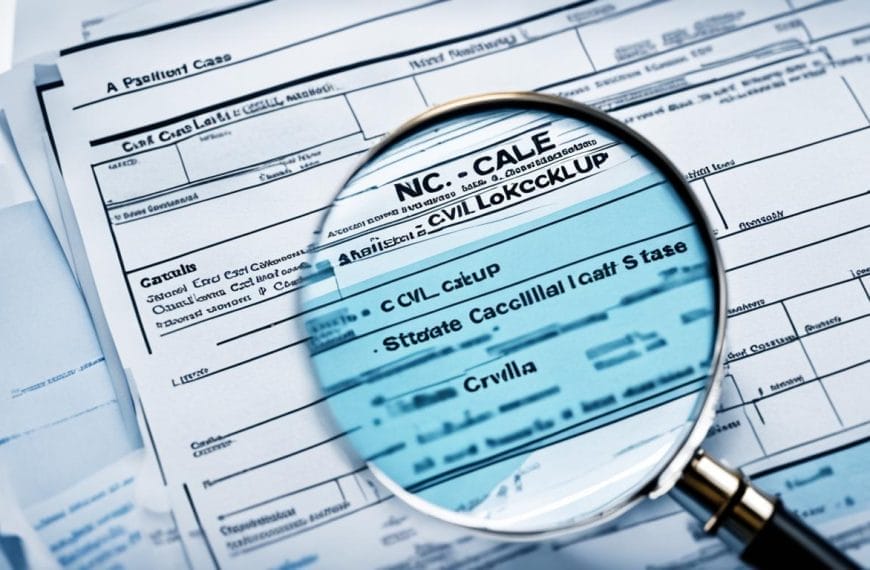Welcome to our comprehensive guide on the civil litigation life cycle. Whether you’re a legal professional or someone with a civil lawsuit, understanding the process is essential. Throughout this article, we’ll break down the stages involved, from the initial pleadings to post-trial and even explore alternatives to litigation.
The civil litigation process can seem complex and daunting, but with a clear understanding of the timeline and steps involved, you can navigate it effectively. So, let’s dive into the civil lawsuit timeline and explore the different stages that make up the civil litigation process.
In Section 2, we’ll start with the first stage: pleadings. This stage sets the foundation for the entire civil litigation process and involves the plaintiff filing a complaint with the court, outlining the allegations and legal basis for the case. The defendant then has the opportunity to file an answer, responding to the claims made in the complaint. The pleadings stage is crucial as it establishes the key issues of the case and initiates the legal battle.
Stay tuned for Section 3, where we’ll delve into the discovery phase. In this stage, the parties involved gather relevant information through various methods like written questions, requests for documents, and depositions. Discovery is a crucial part of building each party’s case and plays a significant role in the trial process.
Next, in Section 4, we’ll explore the heart of civil litigation: the trial. Here, both sides present their evidence, arguments, and witness testimonies to a judge and/or jury. It’s during this stage that the facts of the case are thoroughly examined and a decision or verdict is reached. We’ll guide you through the trial process, which includes opening statements, presentation of evidence, cross-examination, and closing arguments.
After the trial, we’ll move on to Section 5, where we’ll discuss the post-trial options available. Parties may file motions challenging the verdict and even explore the possibility of an appeal. We’ll outline the different motions that can be filed and provide insights into the appellate process.
In Section 6, we’ll cover alternatives to litigation. Sometimes, parties may prefer to avoid the lengthy and costly process of litigation. We’ll explore settlement discussions, mediation, and arbitration as viable alternatives, each offering its own unique advantages and considerations.
In conclusion, comprehending the civil litigation process is essential for anyone involved in a civil lawsuit. By breaking down the life cycle into digestible steps, we aim to provide you with valuable insights and knowledge. So, let’s get started with Section 2 and explore the intriguing world of pleadings in civil litigation.
Pleadings in Civil Litigation
The first stage of the civil litigation process is the pleadings. This crucial step sets the foundation for the entire case by allowing the parties to present their initial claims and defenses to the court.
At the heart of the pleadings stage is the complaint. The plaintiff, who initiates the lawsuit, files a formal complaint with the court. The complaint outlines the allegations against the defendant and provides the legal basis for the case. It is essential for the plaintiff to clearly state the facts and legal theories supporting their claims.
Once the complaint is filed, the defendant has the right to respond by filing an answer. The answer addresses each allegation made in the complaint and either admits or denies them. The defendant may also assert affirmative defenses, which challenge the legal validity of the plaintiff’s claims.
In addition to filing an answer, the defendant may choose to file counter-claims against the plaintiff. Counter-claims are separate claims made by the defendant against the plaintiff, either related to the original dispute or arising from a different set of facts.
The pleadings stage is critical as it shapes the framework of the lawsuit. It allows each party to clearly communicate their positions and sets the stage for the subsequent stages of the civil litigation process. A well-crafted complaint and a robust response can significantly impact the outcome of the case.
Key Takeaways:
- The pleadings stage is the first step in the civil litigation process.
- The plaintiff initiates the lawsuit by filing a complaint with the court, outlining the allegations and legal basis for the case.
- The defendant responds by filing an answer, admitting or denying the allegations, and asserting affirmative defenses.
- The defendant may also file counter-claims against the plaintiff.
- The pleadings stage sets the foundation for the case and shapes the subsequent stages of civil litigation.
Discovery in Civil Litigation
Once the initial pleadings stage is completed, the next phase in civil litigation is discovery. This crucial stage allows each party to obtain relevant information and evidence from the opposing side, as well as third parties, to build a strong case. Discovery is a process of uncovering the facts and details of the case, ensuring that both parties have access to the same information, and promoting the fair resolution of the dispute.
Discovery in civil litigation involves various methods of obtaining information, including:
- Interrogatories: Written questions that one party sends to the other, which must be answered under oath. Interrogatories are a valuable tool for obtaining information about the opposing party’s claims, defenses, witnesses, and other relevant details.
- Requests for documents: Formal requests made by one party to the other, seeking the production of specific documents that are relevant to the case. This could include contracts, emails, financial records, or any other documents that are pertinent to the claims and defenses presented.
- Depositions: Oral examinations conducted under oath, in which attorneys have the opportunity to ask questions to witnesses or parties involved in the case. Depositions serve as a means of obtaining sworn testimony and evaluating the credibility of potential witnesses.
The discovery phase can be lengthy and intricate, with each party having the opportunity to present and request information. It is essential for attorneys to meticulously review and analyze the obtained information to strategize their case effectively.
To illustrate the process visually, here is an example of a table showcasing the different methods of discovery:
| Discovery Method | Description |
|---|---|
| Interrogatories | Written questions exchanged between parties, requiring detailed written responses under oath. |
| Requests for Documents | Formal requests to produce specific documents, such as contracts, emails, or financial records. |
| Depositions | Oral examinations conducted under oath, allowing attorneys to question witnesses or parties involved in the case. |
Trial in Civil Litigation
Once the discovery phase is complete and the case does not settle, it progresses to the trial stage.
During a civil litigation trial, each side has the opportunity to present their evidence and arguments before a judge and/or jury. This crucial step allows the parties to advocate for their positions and attempt to persuade the decision-maker.
The trial begins with opening statements, where attorneys provide an overview of their case and set the stage for the evidence to come. Opening statements often serve to outline the main arguments and provide a roadmap for the trial.
Following the opening statements, the presentation of evidence commences. This can include testimonies from witnesses, documents, photographs, videos, or any other relevant material. The goal is to present compelling evidence that supports the claims or defenses asserted.
Throughout the trial, there may be instances of cross-examination, where opposing counsel questions witnesses to challenge their credibility or elicit favorable testimony. Cross-examination is an opportunity to test the strength of the evidence and weaken the opposing party’s case.
Once all evidence has been presented, the trial culminates with closing arguments. Attorneys deliver their final persuasive speeches, summarizing the evidence and urging the judge or jury to rule in their favor. Closing arguments are the last opportunity to make a compelling case before deliberations.
After the closing arguments, the judge or jury will deliberate and reach a decision. In a civil litigation trial, the outcome may be determined by a preponderance of the evidence, meaning that one side has presented more convincing evidence than the other. The decision reached at this stage is known as a verdict.
The trial stage of civil litigation is where the arguments and evidence are put to the test, leading to a crucial judgment that can significantly impact the outcome of the case.
Post-Trial and Appeals in Civil Litigation
Once a trial is complete, there are important post-trial options that parties can explore in civil litigation. These options include filing motions and potentially pursuing an appeal in a higher court.
After a trial, a party may choose to file various motions to challenge the verdict or seek further action. Some common motions include:
- Motion for judgment notwithstanding the verdict
- Motion for a new trial
These motions provide an opportunity to present legal arguments and evidence to challenge the trial court’s decision.
If a party is dissatisfied with the outcome of the trial and believes there were legal errors or issues that affected the judgment, they may choose to appeal the decision to a higher court. The appeal process allows the appellate court to review the trial court’s proceedings and determine if any legal errors occurred.
The appeal process typically involves:
- Filing a notice of appeal
- Preparing and submitting appellate briefs
- Oral arguments
- The appellate court’s decision
The appellate court has the power to affirm the trial court’s decision, reverse the decision, or order a new trial.
Example Table – Appeals in Civil Litigation
| Appeal Grounds | Possible Outcomes |
|---|---|
| Legal errors during trial | Reversal of the trial court’s decision |
| Lack of substantial evidence to support the verdict | Remand for a new trial |
| Improper jury instructions | Order a new trial |
It’s important to note that the appeals process can be complex and requires adherence to strict procedural rules. Seeking the assistance of an experienced appellate attorney is recommended when pursuing an appeal.
Alternatives to Litigation
While civil litigation is an established method for resolving legal disputes, it may not always be the most efficient or cost-effective option. Fortunately, there are alternatives to litigation that parties can consider. These alternatives provide opportunities for reaching agreements and resolving disputes outside of the courtroom. Three common alternatives to civil litigation are settlement, mediation, and arbitration.
Settlement:
Settlement involves negotiations between the parties to reach a mutually agreeable resolution. This can be done at any stage of the litigation process, even before a lawsuit is filed. Settlement discussions can be facilitated by the parties themselves or their attorneys. By arriving at a settlement, both parties can avoid the time, expense, and uncertainty associated with a trial.
Mediation:
Mediation is a voluntary process where the parties enlist the help of a neutral third party known as a mediator. The mediator assists in facilitating communication and negotiation between the parties to reach a resolution. The mediator does not make decisions but helps guide the parties towards a mutually satisfactory outcome. Mediation allows for flexibility and can be especially valuable in maintaining relationships between the parties.
Arbitration:
If the parties prefer a more formal process but want to avoid going to court, arbitration is an alternative to consider. In arbitration, a neutral third party, known as an arbitrator, reviews the evidence presented by both sides and makes a binding decision. This method offers a streamlined and efficient process compared to traditional litigation. Arbitration can be held in a private setting and is often less formal than a courtroom trial.
Each alternative to litigation has its unique advantages and considerations. The table below provides a comparative overview of settlement, mediation, and arbitration:
| Settlement | Mediation | Arbitration | |
|---|---|---|---|
| Process | Parties negotiate directly or with attorney representation | Neutral mediator facilitates communication and negotiation | Neutral arbitrator reviews evidence and makes a binding decision |
| Control | Parties have control over the outcome | Parties have control over the outcome | Arbitrator makes a decision |
| Confidentiality | Settlement terms can remain confidential | Mediation sessions are confidential | Arbitration can be confidential, depending on the agreement |
| Decision | Parties reach an agreement | Parties reach an agreement | Arbitrator makes a binding decision |
| Enforceability | Settlement agreement is binding and enforceable | Mediation agreement can be binding and enforceable | Arbitration award is binding and enforceable |
Conclusion
The civil litigation process is a comprehensive framework consisting of multiple stages that contribute to the resolution of a civil lawsuit. From the initial pleadings to potential appeals, each step holds significant importance in the pursuit of justice. During this process, parties involved may also explore alternatives to litigation, such as settlement, mediation, and arbitration, which can provide efficient and cost-effective means of resolution.
Understanding the civil litigation process is crucial for all parties involved. By having a clear understanding of each stage, individuals are better equipped to navigate the complexities and make informed decisions. Whether it is filing a complaint, responding to an answer, engaging in discovery, presenting evidence at trial, or pursuing post-trial motions, every action contributes to the overall progression of the case.
Additionally, parties should be aware of the alternative dispute resolution mechanisms available to them. Settlement discussions, mediated negotiations, and arbitrated resolutions offer viable options to resolve conflicts outside of the courtroom. These alternatives often promote a mutually beneficial outcome while avoiding the time and expenses associated with traditional litigation.
In summary, the civil litigation process encompasses various stages, each with its own role and significance. By thoroughly understanding this process and exploring alternative avenues, parties can effectively safeguard their rights and seek a fair and just resolution for their civil disputes.













